This is an AI Free Zone! Text created by Large Language Models is spreading rapidly across the Internet. It's well-written, artificial, frequently inaccurate. If you find a mistake on Spaceweather.com, rest assured it was made by a real human being. | | |
CME IMPACT SPARKS GEOMAGNETIC STORM: Yesterday, Aug. 27th, a CME struck Earth. At first, the CME's impact appeared weak and, indeed, it did not cause an immediate geomagnetic storm. However, during the early hours of Aug. 28th, magnetic fields in the CME's wake linked to Earth's magnetic field, causing storms of category G2. Auroras were photographed in Europe and the USA. CME impact alerts: SMS Text
"This morning, on August 28, 2024, around 1 AM (UTC) faint auroras appeared over the Czech Republic," reports Petr Horálek, who sends this picture from the shore of Seč Lake:
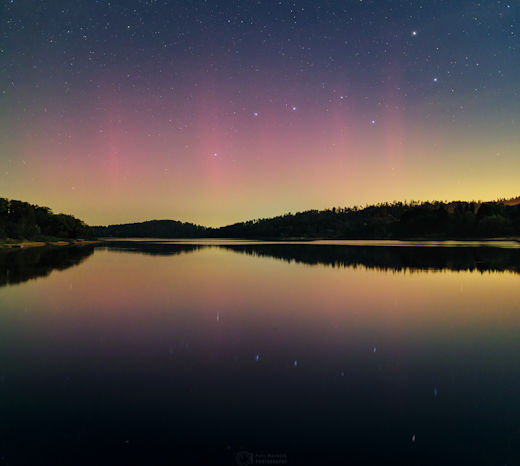
"What a year, so many auroras from central Europe have not been visible since 2001!" he says.
more images: from Oliver Schwenn of Skagen, Danmark; from Jeremy Rogers in the Pawnee National Grasslands of Weld County, Colorado; from Calvin Cannon of Madras, Oregon; from Graeme Whipps of Aberdeenshire, Scotland; from Harlan Thomas of Lake Alberta, Canada;
Realtime Aurora Photo Gallery
Free: Spaceweather.com Newsletter
INCOMING 'DAYLIGHT COMET' IS STILL ALIVE: Amateur astronomers have been wondering how Comet Tsuchinshan-ATLAS (C/2023 A3) is doing. NASA has an answer: "It's still alive." The incoming comet, which could become visible in broad daylight in October, was spotted this month by NASA's STEREO-A spacecraft apparently in good health on the other side of the sun. Click to set the scene in motion:
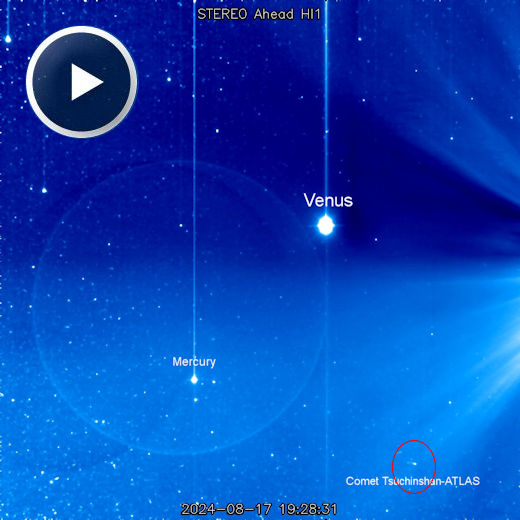
Note: Can't find the comet? It's inside the red ellipse.
Astronomers on Earth have not been able to track the comet for weeks because of the sun's glare. STEREO-A's movie is reassurance that the comet has not broken apart despite predictions to the contrary.
Astronomer Qicheng Zhang of the Lowell Observatory is optimistic about the comet's chances:"It continues to brighten steadily, and is now up to magnitude 7," he says. "It also continues to display a very robust ion tail. There are zero signs that the nucleus is disintegrating."
This is good news for sky watchers. If Tsuchinshan-ATLAS can hold itself together just a little longer, it will become a naked-eye object in late Sept. and October. Zhang predicts "the comet will brighten to magnitude +4 ± 1 at perihelion on Sept. 27th, to a daylight peak of -3 ± 1 near inferior conjunction on Oct. 9th, and subsequently produce a quite possibly 20+ degree dust tail visible under dark skies (Oct ~19) before fading away."
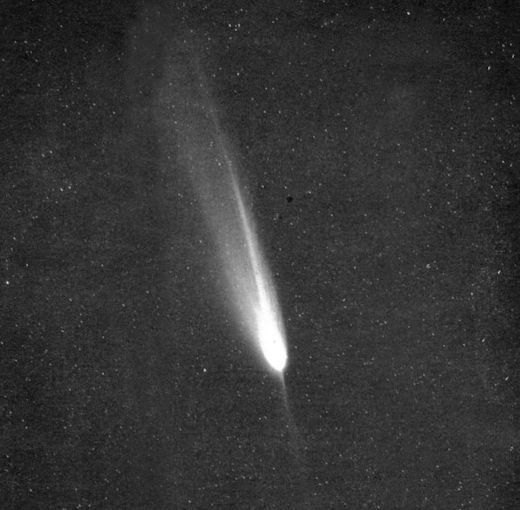
Comet Arend-Roland in 1957 may be "very similar" to Tsuchinshan-ATLAS in 2024
"It reminds me of the very similar Comet Arend-Roland in 1957, whose combined tails extended several tens of degrees for a few days," notes Zhang. "I consider a comparable display to be by far the most likely scenario for mid-October."
The comet will re-emerge from sunlight in mid-September, becoming visible to telescopes in the southern hemisphere. How will it be doing then? Stay tuned!
Realtime Space Weather Photo Gallery
Free: Spaceweather.com Newsletter
LASER-ETCHED MOON CRYSTAL: On Aug. 16th, the students of Earth to Sky Calculus launched a cosmic ray balloon to the stratosphere. This laser-etched Moon cube went along for the ride, floating in the stratosphere for more than 3 hours at an altitude of 103,130 feet:
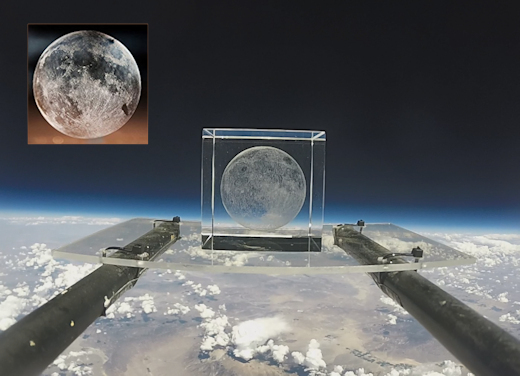
You can have it for $129.95. Inside the crystal cube, a laser has etched authentic lunar topography with all major craters, mountains and lava plains accurately portrayed. This gift comes with a unique gift card showing the cube in flight and telling the story of its journey to the edge of space and back again.
Far Out Gifts: Earth to Sky Store
All sales support hands-on STEM education
Realtime Aurora Photo Gallery
Free: Spaceweather.com Newsletter
Realtime Comet Photo Gallery
Free: Spaceweather.com Newsletter
Realtime Noctilucent Cloud Photo Gallery
Free: Spaceweather.com Newsletter
Every night, a network of
NASA all-sky cameras scans the skies above the United States for meteoritic fireballs. Automated software maintained by NASA's Meteoroid Environment Office calculates their orbits, velocity, penetration depth in Earth's atmosphere and many other characteristics. Daily results are presented here on Spaceweather.com.
On Aug 28, 2024, the network reported 9 fireballs.
(9 sporadics)
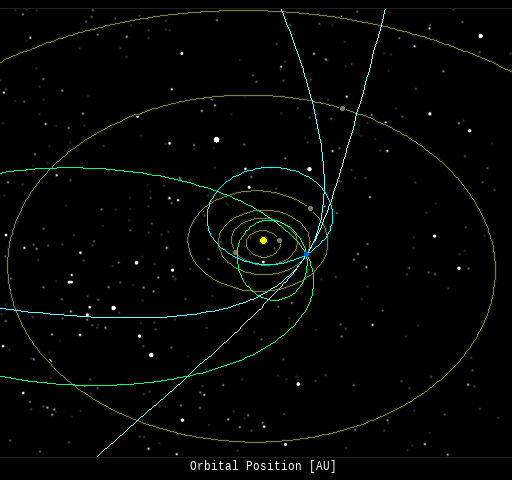
In this diagram of the inner solar system, all of the fireball orbits intersect at a single point--Earth. The orbits are color-coded by velocity, from slow (red) to fast (blue). [Larger image] [movies]
Potentially Hazardous Asteroids (
PHAs) are space rocks larger than approximately 100m that can come closer to Earth than 0.05 AU. None of the known PHAs is on a collision course with our planet, although astronomers are finding
new ones all the time.
On August 28, 2024 there were 2349 potentially hazardous asteroids.
 |
Recent & Upcoming Earth-asteroid encounters: | Asteroid | Date(UT) | Miss Distance | Velocity (km/s) | Diameter (m) |
| 2024 QT | 2024-Aug-24 | 3.2 LD | 6.4 | 9 |
| 2024 QF | 2024-Aug-24 | 5.5 LD | 12 | 18 |
| 2024 QN | 2024-Aug-24 | 2 LD | 7.9 | 20 |
| 2020 RL | 2024-Aug-27 | 12.2 LD | 8.2 | 34 |
| 2024 QQ | 2024-Aug-28 | 3.1 LD | 4.9 | 10 |
| 2024 QK | 2024-Aug-28 | 19 LD | 12.7 | 52 |
| 2024 QG | 2024-Aug-28 | 4.3 LD | 22.4 | 41 |
| 2021 RA10 | 2024-Aug-28 | 6.8 LD | 4.9 | 29 |
| 2024 QL | 2024-Aug-29 | 3.1 LD | 10.7 | 14 |
| 2012 SX49 | 2024-Aug-29 | 11.2 LD | 4.3 | 20 |
| 2016 RJ20 | 2024-Aug-30 | 18.3 LD | 14.8 | 68 |
| 2021 JT | 2024-Sep-01 | 16.4 LD | 8.2 | 12 |
| 2021 RB16 | 2024-Sep-02 | 12.3 LD | 8.4 | 15 |
| 2007 RX8 | 2024-Sep-02 | 18.5 LD | 7 | 44 |
| 2022 SR | 2024-Sep-07 | 9.1 LD | 6.3 | 42 |
| 2024 QS | 2024-Sep-09 | 12.2 LD | 9.3 | 43 |
| 2023 SP2 | 2024-Sep-09 | 15.3 LD | 4.2 | 8 |
| 2024 PM6 | 2024-Sep-09 | 14 LD | 9 | 49 |
| 2016 TU19 | 2024-Sep-11 | 13.2 LD | 10.1 | 47 |
| 2019 DJ1 | 2024-Sep-15 | 10.4 LD | 4.9 | 15 |
| 2024 ON | 2024-Sep-17 | 2.6 LD | 8.9 | 293 |
| 2013 FW13 | 2024-Sep-18 | 8.5 LD | 15.6 | 162 |
| 2022 SW3 | 2024-Sep-19 | 6.8 LD | 9.2 | 37 |
| 2015 SH | 2024-Sep-19 | 11.6 LD | 5.9 | 9 |
| 2023 RX1 | 2024-Sep-20 | 10.1 LD | 1.1 | 3 |
| 2018 VG | 2024-Sep-20 | 13.4 LD | 7.3 | 12 |
| 2020 GE | 2024-Sep-24 | 1.7 LD | 2.2 | 8 |
| 2011 ST12 | 2024-Sep-27 | 17.6 LD | 7.4 | 19 |
| 2023 GM1 | 2024-Oct-05 | 15.4 LD | 5.2 | 13 |
| 2014 VA | 2024-Oct-05 | 18.1 LD | 6.3 | 46 |
| 2022 SU21 | 2024-Oct-06 | 17.5 LD | 21.1 | 45 |
| 671076 | 2024-Oct-07 | 12.8 LD | 8.6 | 120 |
| 2016 JG38 | 2024-Oct-08 | 13.2 LD | 12 | 56 |
| 2018 QE | 2024-Oct-09 | 1.7 LD | 4.4 | 10 |
| 363027 | 2024-Oct-12 | 9.3 LD | 16.6 | 419 |
| 2020 GE1 | 2024-Oct-12 | 20.1 LD | 4.3 | 14 |
| 2022 UX1 | 2024-Oct-12 | 19.9 LD | 9.9 | 9 |
| 2008 UU95 | 2024-Oct-12 | 13.5 LD | 15.6 | 66 |
| 2021 TK11 | 2024-Oct-14 | 8 LD | 10.6 | 7 |
| 2022 TB41 | 2024-Oct-15 | 10 LD | 6 | 4 |
| 2019 UH14 | 2024-Oct-17 | 8.3 LD | 10.4 | 62 |
| 2015 HM1 | 2024-Oct-24 | 14.4 LD | 10.9 | 32 |
| 363305 | 2024-Oct-24 | 11.8 LD | 4.9 | 186 |
| 2021 UE2 | 2024-Oct-24 | 13.6 LD | 7.1 | 40 |
| 2023 TG14 | 2024-Oct-24 | 6.6 LD | 6.9 | 24 |
| 2007 UT3 | 2024-Oct-26 | 17.7 LD | 10.4 | 23 |
Notes: LD means "Lunar Distance." 1 LD = 384,401 km, the distance between Earth and the Moon. 1 LD also equals 0.00256 AU. | | Cosmic Rays in the Atmosphere |
SPACE WEATHER BALLOON DATA: Almost once a week, Spaceweather.com and the students of Earth to Sky Calculus fly space weather balloons to the stratosphere over California. These balloons are equipped with sensors that detect secondary cosmic rays, a form of radiation from space that can penetrate all the way down to Earth's surface. Our monitoring program has been underway without interruption for 7 years, resulting in a unique dataset of in situ atmospheric measurements.
Latest results (July 2022): Atmospheric radiation is decreasing in 2022. Our latest measurements in July 2022 registered a 6-year low:
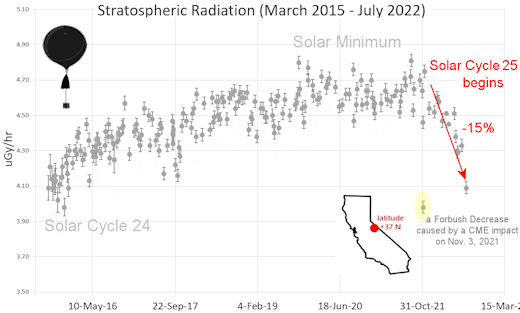
What's going on? Ironically, the radiation drop is caused by increasing solar activity. Solar Cycle 25 has roared to life faster than forecasters expected. The sun's strengthening and increasingly tangled magnetic field repels cosmic rays from deep space. In addition, solar coronal mass ejections (CMEs) sweep aside cosmic rays, causing sharp reductions called "Forbush Decreases." The two effects blend together to bring daily radiation levels down.
.Who cares? Cosmic rays are a surprisingly "down to Earth" form of space weather. They can alter the chemistry of the atmosphere, trigger lightning, and penetrate commercial airplanes. According to a study from the Harvard T.H. Chan school of public health, crews of aircraft have higher rates of cancer than the general population. The researchers listed cosmic rays, irregular sleep habits, and chemical contaminants as leading risk factors. A number of controversial studies (#1, #2, #3, #4) go even further, linking cosmic rays with cardiac arrhythmias and sudden cardiac death.
Technical notes: The radiation sensors onboard our helium balloons detect X-rays and gamma-rays in the energy range 10 keV to 20 MeV. These energies span the range of medical X-ray machines and airport security scanners.
Data points in the graph labeled "Stratospheric Radiation" correspond to the peak of the Regener-Pfotzer maximum, which lies about 67,000 feet above central California. When cosmic rays crash into Earth's atmosphere, they produce a spray of secondary particles that is most intense at the entrance to the stratosphere. Physicists Eric Regener and Georg Pfotzer discovered the maximum using balloons in the 1930s and it is what we are measuring today.
| | The official U.S. government space weather bureau |
| | The first place to look for information about sundogs, pillars, rainbows and related phenomena. |
| | Researchers call it a "Hubble for the sun." SDO is the most advanced solar observatory ever. |
| | 3D views of the sun from NASA's Solar and Terrestrial Relations Observatory |
| | Realtime and archival images of the Sun from SOHO. |
| | information about sunspots based on the latest NOAA/USAF Active Region Summary |
| | current counts of failed and deployed Starlink satellites from Jonathan's Space Page. See also, all satellite statistics. |
| | Authoritative predictions of space junk and satellite re-entries |
| | from the NOAA Space Environment Center |
| | fun to read, but should be taken with a grain of salt! Forecasts looking ahead more than a few days are often wrong. |
| | from the NOAA Space Environment Center |
| | the underlying science of space weather |
 | Got a chipped or cracked windshield that prevents you from seeing space weather events while driving? Get windshield replacement from SR Windows & Glass with free mobile auto glass service anywhere in the Phoenix area. |
 | Marketing yourself on YouTube is hard without real organic views on your videos. You can buy organic YouTube views from and enjoy social boosting that is actually real. Highly recommended! |
 | BestCSGOGambling is the best site for everything related to CSGO gambling on the web |
| | These links help Spaceweather.com stay online. Thank you to our supporters! |
| | | | | | |

